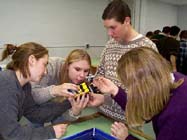|
| |
|
Definition Cognitive apprenticeships are situated within the social constructivist paradigm. They suggest students work in teams on projects or problems with close scaffolding of the instructor. Cognitive apprenticeships are representative of Vygotskian "zones of proximal development" in which student tasks are slightly more difficult than students can manage independently, requiring the aid of their peers and instructor to succeed. Cognitive apprenticeships reflect situated cognition theory, as do anchored instruction modules described on a previous page. Download annotated Powerpoint slides describing the cognitive apprenticeship model (PDF File). |
|
Relevant Examples If you have created course materials at Virginia Tech that are representative of this teaching model, we would like to showcase your work here. Please contact us with a description of your project so other faculty may learn from your efforts. |
|
Design and Development Tips Programs that allow realistic situations to be represented are
suitable for designing situated materials. For instance, authoring
programs allow realistic cases or simulations to be represented as
multimedia. Understanding video, audio, and image editing software will
facilitate the creation of multimedia. In situated cognition, problem solving activities should not be
"neat" and pre-defined, but rather, complex with students required to
discover relevant procedures. Thus, a situated multimedia program will not
reflect a drill-and-practice environment, but more closely approximate a
resource set from which relevant information is sorted and derived by
students. Herrington and Oliver (1997) suggest the use of expert performances
and models in situated multimedia (e.g., including a video clip of an MBA
graduate modelling strategic decisions in the workplace). Multimedia
should not flow in a linear fashion, but provide students with multiple
perspectives on presented issues that they must judge. Further, multimedia
should require students to collaborate and act upon presented information,
by developing hypotheses and solution plans in teams. Coaching and
scaffolding is a key part of situated materials. Although hints and
prompts can be embedded in programs, teachers will need to closely monitor
student use and understanding of programmed help, providing additional
support when needed. Perhaps the most critical component of situated learning is communication among peers. This component may be best elicited by designing technology-free discussions, debates, interviews, and other face-to-face activities. If desired, web-based tools such as discussion boards and chat rooms may promote additional communication and problem discussion. |
Recommended Readings
| |
